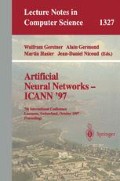Abstract
It is assumed that higher order concept formation utilizes independent components (ICs). It is argued that ICs require dynamic input reconstruction networks (RNs) to form a reliable internal representation. Input reconstruction, however, can be slow and poor with ICs on substrates with lossy dynamics. A model of the hippocampal formation is proposed that develops the ICs on lossy RNs by means of locking inputs to the internal representation and thus forcing fast reconstruction and cancelling losses. It is assumed that upon training ICs can lock themselves, thus hippocampal lesion mostly affects anterograde memories.
Preview
Unable to display preview. Download preview PDF.
References
Kalmár, Z., Szepesvàri, C., Lőrincz, A.: Generalized dynamic concept model as a route to construct adaptive autonomous agents. Neural Network World 5 (1995) 353–360
Jutten, C., Herault, J.: Blind separation of sources, Part 1: An adaptive algorithm based on neuromimetic architecture. Signal Processing 24 (1991) 1–10
Comon, C.: Independent component analysis-A new concept?. Signal Processing 36 (1994) 287–314
Karhunen, J., Oja, E., Wang, L., Vigário, R., Joutsensalo, J.: A class of neural networks for independent component analysis. IEEE Trans. on Neural Networks (1997) In press
Lőrincz, A.: Towards a unified model of cortical computation II: From control architecture to a model of consciousness. Neural Network World 7 (1997) 137–152
Szepesvàri, C., Cimmer, S., L6rincz, A.: Dynamic state feedback neurocontroller for compensatory control. Neural Networks (1997) In press
Szepesvàri, C., Lőrincz, A.: Approximate inverse-dynamics based robust control using static and dynamic state feedback. Neural Adaptive Control Theory, World Sci. Singapore, 2 In press
Laheld, B., Cardoso, J.F.: Adaptive source separation with uniform performance. Proc. EUSIPCO-94 2 (1994) 183–186
Bell, A.J., Sejnowski, T.J.: Edges are the independent components of natural scenes. Advances in Neural Information Processing Systems 9 (1997) 831–837
Buzsáki, Gy.: Two-stage model of memory trace formation: A role for “noisy” brain states. Neuroscience 31 (1989) 551–570
Author information
Authors and Affiliations
Editor information
Rights and permissions
Copyright information
© 1997 Springer-Verlag Berlin Heidelberg
About this paper
Cite this paper
Lőrincz, A. (1997). Hippocampal formation trains independent components via forcing input reconstruction. In: Gerstner, W., Germond, A., Hasler, M., Nicoud, JD. (eds) Artificial Neural Networks — ICANN'97. ICANN 1997. Lecture Notes in Computer Science, vol 1327. Springer, Berlin, Heidelberg. https://doi.org/10.1007/BFb0020150
Download citation
DOI: https://doi.org/10.1007/BFb0020150
Published:
Publisher Name: Springer, Berlin, Heidelberg
Print ISBN: 978-3-540-63631-1
Online ISBN: 978-3-540-69620-9
eBook Packages: Springer Book Archive

